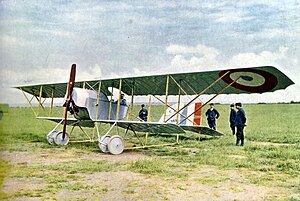Caudron G.3
| Caudron G.3 | |
|---|---|

| |
| Role | Reconnaissance/Bomber |
| Manufacturer | Caudron |
| First flight | 1913 [1] |
| Introduction | May 1914 [2] or Sep 1914[3] |
| Primary users | |
| Number built | 2800 [note 1] |
| Developed from | Caudron G.2 |
| Wingspan | 13.4 m (43 ft 11.5 in) [6][3][7][5] [note 2] |
| Engine | 80-100hp Anzani radial or 80hp Gnome rotary or 80hp Le Rhône rotary or 70hp Renault inline |
| Crew | 2 |
| Max Speed | 110 km/h (68 mph)[5]-112 km/h (70 mph)[7][6][4] to 136.0 km/h (84.5 mph)[3] |
| Climb | 1,000 m (3,280 ft) in 7:00[6]-8:00[5] 2,000 m (6,560 ft) in 16:00[6]-18:00[7][4][5]-20:00[3] 3,000 m (9,840 ft) in 30:00[5]-32:00[7][6][4] |
| Ceiling | 4,000 m (13,100 ft)[5] |
| Endurance | 4:00 [7][6][3][4][5] |
The Caudron G.3 was a tractor biplane with the engine mounted at the front of a small central nacelle in which a crew of one or two resided. The view from the nacelle was fairly obstructed, and swapping the crew -- as was sometimes done -- did little to improve it. Despite these limitations, around 2,800 G.3's were built and they served with not only Aviation Militaire but with five Italian squadriglia, Romania (12 aircraft), Russia (20), and the U.K., where they were used in small numbers from March-October 1915. U.K.-built G.3's had a somewhat smaller wingspan and greater length than the original design.
The G.3 saw an even longer life as a trainer, where it was used well into the 1920's. [1]
The plane was very stable and mild-mannered, an advantage with the lightly-trained pilots of 1914 and with student flyers. While early models all used warping (even on the elevators), later models used hinged elevators. As with the earlier Caudron G.2, two small fins with rudders were used for yaw control. A variety of engines was used, with Anzani being most common in trainers. As a trainer, it also saw service with China and the US. Many famous French pilots got their start in the G.3.[8]
170 G.3's were built in Italy under license by A.E.R. Finding the low-power rotary engines inadequate for bad-weather and high-altitude flying, the Italians replaced some of their Le Rhône engines with the Fiat A.10 or 150hp Isotta-Fraschini engines.[5]
For more information, see Wikipedia:Caudron G.3.
Timeline [note 3] [note 4]

Game Data
Wings of Glory
| Availability | Maneuver | Damage | Dmg Points | Max Alt. | Climb |
|---|---|---|---|---|---|
| 14Q3-17Q4 | XC | - or B | 12 | 10 | 6 |
Card Links
Blue Max/Canvas Eagles
Miniatures and Models
1:144 Scale
- Shapeways: Decapod, Kampfflieger, Reduced Aircraft Factory
- U.K.-built version: Reduced Aircraft Factory
- Table Top Flights
1:285/6mm/1:288 Scale
- Shapeways: Reduced Aircraft Factory
- U.K.-built version: Reduced Aircraft Factory
Resources
Orthographic Drawings
-
U.K.-built model
References
- Notes
- ↑ ≥2450 in France[2][3][4], 50[4]-350[2] in Britain, 170 in Italy[5]
- ↑ G.3's built by British Caudron had a wingspan of 13.26 m (43 ft 6 in).[7][4]
- ↑ Plane counts are approximate and based of escadrille usage in Davilla'97.
- ↑ British usage numbers are approximate, derived from the squadron histories.[9]
- Citations
- ↑ 1.0 1.1 Davilla'97, p.142.
- ↑ 2.0 2.1 2.2 Guttman, p.3.
- ↑ 3.0 3.1 3.2 3.3 3.4 3.5 Ferry'14, p.51.
- ↑ 4.0 4.1 4.2 4.3 4.4 4.5 4.6 Guttman'02, p.36.
- ↑ 5.0 5.1 5.2 5.3 5.4 5.5 5.6 5.7 5.8 Davilla Italian Vol.2, pp.181-185.
- ↑ 6.0 6.1 6.2 6.3 6.4 6.5 Lamberton, pp.216-218.
- ↑ 7.0 7.1 7.2 7.3 7.4 7.5 Davilla'97, p.147.
- ↑ Guttman'02.
- ↑ Philpott'13, pp.379-444.
- Bibliography
- Dr. James J. Davilla and Arthur M. Soltan. French Aircraft of the First World War. Flying Machines Press, 1997. ISBN 0-9637110-4-0.
- James Davilla, MD, Italian Aviation in the First World War, Volume 2, Aircraft A-H. USA: Aeronaut Books, 2023. ISBN 978-1-953201-80-5
- Vital Ferry. French Aviation During the First World War. Paris: Histoire and Collections, 2014. ISBN 978-2-35250-370-5
- Jon Guttman, Windsock Datafile 94: Caudron G.3. Great Britain: Albatros Publications Ltd., 2002. ISBN 1-902207-49-1
- Jon Guttman, Windsock Datafile 96: Caudron G.4. Great Britain: Albatros Publications Ltd., 2002. ISBN 1-902207-51-3
- W.M. Lamberton and E.F. Cheesman, Reconnaissance & Bomber Aircraft of the 1914-1918 War. Great Britain: Harleyford Publications Ltd., 1962. ISBN 9780900435027
- Ian Philpott, The Birth of the Royal Air Force. Great Britain: Pen & Sword Books Limited, 2013. ISBN 978-1-78159-333-2

